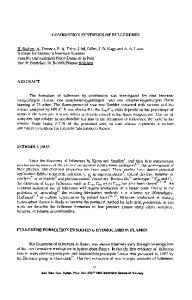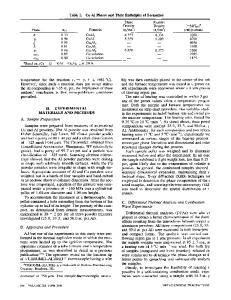The mechanism of combustion synthesis of titanium carbonitride
- PDF / 523,001 Bytes
- 5 Pages / 612 x 828 pts Page_size
- 39 Downloads / 371 Views
Titanium carbonitride, T1C0.5N0.5, is synthesized directly by a self-propagating reaction between titanium and carbon in a nitrogen atmosphere. Complete conversion to the carbonitride phase is achieved with the addition of TIN as diluent and with a nitrogen pressure 3=0.6 MPa. Thermodynamic phase-stability calculations and experimental characterizations of quenched samples support a proposed mechanism in which the formation of the carbonitride is a two-step process. The first step involves the formation of the nonstoichiometric carbide, TiC0.5, and is followed by the formation of the product by the incorporation of nitrogen in the defect-structure carbide to form the carbonitride solid solution.
I. INTRODUCTION The carbide and nitride of titanium are of practical interest because of their high hardness, thermal stability, and relatively high thermal and electrical conductivities.1 The solid solution of these refractories, i.e., titanium carbonitride, TiC x N y , has been used in cutting tools and wear-resistant materials when combined with nickel or molybdenum.2-3 There are three methods for producing TiC, TiN, and titanium carbonitride (TiQN y ): (1) the direct chemical reduction of titanium oxide, titanium chloride, or titanium hydride by carbon, nitrogen, and ammonia4"8; (2) solid state diffusion of C, N, or both, into Ti powders at high temperatures (1000-1500 °C) where the reaction takes place over the course of several hours (the carbonitride can also be produced by reacting a mixture of TiC and TiN8"13; (3) self-propagating high-temperature synthesis (SHS) or combustion synthesis of TiC,14"17 TiN,18"21 and TiCN.22 While preparation of TiC and TiN by the SHS method has been studied extensively, research on the formation of TiQNy by this method has been limited. Avakian et al.22 investigated the combustion synthesis of TiCtNy, focusing on the use of liquid nitrogen as a reactant. Much less effort was focused on the use of nitrogen gas, with little attention paid to the mechanism of the synthesis. In this paper we report the results of an investigation of the mechanism of synthesis of titanium carbonitride by the direct reaction of titanium, carbon, and nitrogen gas in a self-propagation combustion mode. Details of the characteristics of this method of synthesis are given in previous reviews.23-26 II. EXPERIMENTAL PROCEDURE The reagents used in this research were powders of titanium, titanium nitride (used as a diluent), carbon, and J. Mater. Res., Vol. 9, No. 2, Feb 1994
http://journals.cambridge.org
Downloaded: 14 Mar 2015
nitrogen gas. The titanium and titanium nitride powders (—325 mesh) were supplied by Alfa Products (Danvers, MA) as 99% pure. The chemical impurities (in wt. %) present in the titanium powder were C (0.07), H (0.2), O (0.21), and Ca (0.01). X-ray diffraction analysis of Ti and TiN powders revealed trace amounts of TiC in the Ti powder and approximately 5 wt. % Ti2N in the TiN powder. The amorphous carbon black used for synthesis of TiQNj, was Regal 250 available from the Cabot Corporati
Data Loading...











